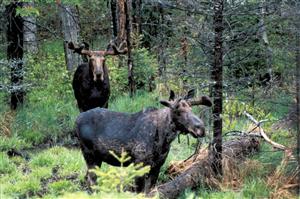Energy and Food
Every organism must acquire energy to live, grow and reproduce. In aquatic ecology, biologists often classify organisms according to how they obtain energy. Because sunlight is the ultimate source of energy used by organisms on the earth's surface, a basic distinction lies between those who use its energy directly—autotrophs—and those who receive it indirectly by consuming other organisms—heterotrophs.
Autotrophs
Autotrophs, or producers, are organisms that can manufacture their own organic material from inorganic sources. Most autotrophs carry out this process using photosynthesis, the process by which plants and algae use solar energy to combine carbon dioxide with water to produce starch, sugars and oxygen. Photosynthesis is the most important biological process on the planet, and its products drive the biological activity of nearly all ecosystems, including aquatic environments. The oxygen produced is available to be used by other organisms, making photosynthesis an important controller of carbon dioxide and oxygen in the environment.
Photosynthesis in aquatic systems is carried out by a wide variety of autotrophs, which range in size from microscopic single-celled organisms to large aquatic plants called macrophytes. Autotrophs are primary producers, because they produce the first level of organic carbon from inorganic compounds. Ultimately, all other types of organisms (heterotrophs) are dependent on the organic carbon produced by autotrophs
Because photosynthesis depends on sunlight, the distribution of autotrophs is reliant in part on the amount of light available in an aquatic ecosystem. In shallow, stony rivers, periphyton (or biofilm) – especially diatoms and cyanobacteria – are the main source of primary production, but shade from riparian vegetation can limit photosynthesis; nutrients may also be in short supply in these habitats. In wider rivers, reduced shading from riparian vegetation allows the river surface to receive more light. However, in deep or turbid sections, light penetration may be insufficient to sustain growth of autotrophs.
Heterotrophs
Heterotrophs, or consumers, are organisms that must obtain energy by consuming other organisms (autotrophs or other heterotrophs) as food. From the perspective of energy flow in ecological systems, heterotrophs can be classified according to what they eat:
- Herbivores are called primary consumers because they eat only plants.
- Carnivores are called secondary consumers because they feed on other animals.
- Omnivores feed both on autotrophs and on other heterotrophs; that is, they eat both plants and animals. Many aquatic organisms, including fish, are omnivorous.
- Detritivores consume dead organic matter (detritus). Detritivores include many bacteria and fungi, invertebrates such as worms and insects, and some scavenging vertebrates. Aquatic insects, for instance, shred dead leaves, but also consume bacteria and fungi growing on the leaves.
Heterotrophs can also be classified according to how they obtain food energy (i.e., functional feeding groups), and by their specific roles in the aquatic ecosystem (Cummins and Klug 1979):
- The grazer-scraper category includes herbivores that feed on periphyton and biofilm. Shredders are detritivores feeding on coarse organic particles, especially leaf litter derived from the riparian zone.
- Collectors eat fine organic particles and can be subdivided according to whether the food particles they collect are suspended in the water (e.g., filtering-collectors or filter-feeders), or have been deposited on the substratum (collector-gatherers).
- Deposit-feeders ingest fine bottom sediments and the organic material that they contain.
- Predators are species that eat other animals.









